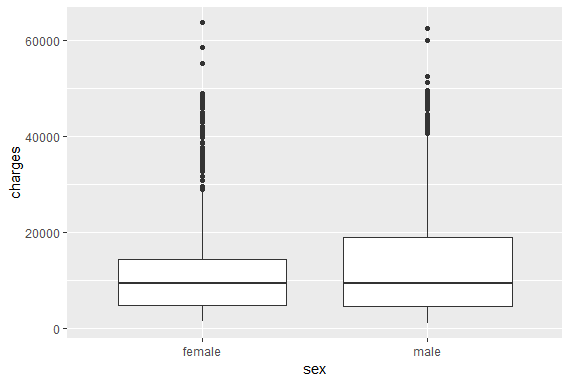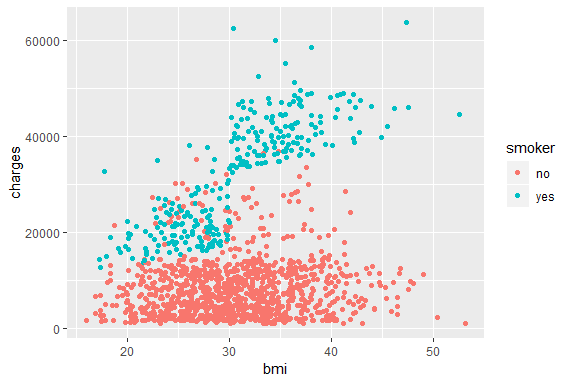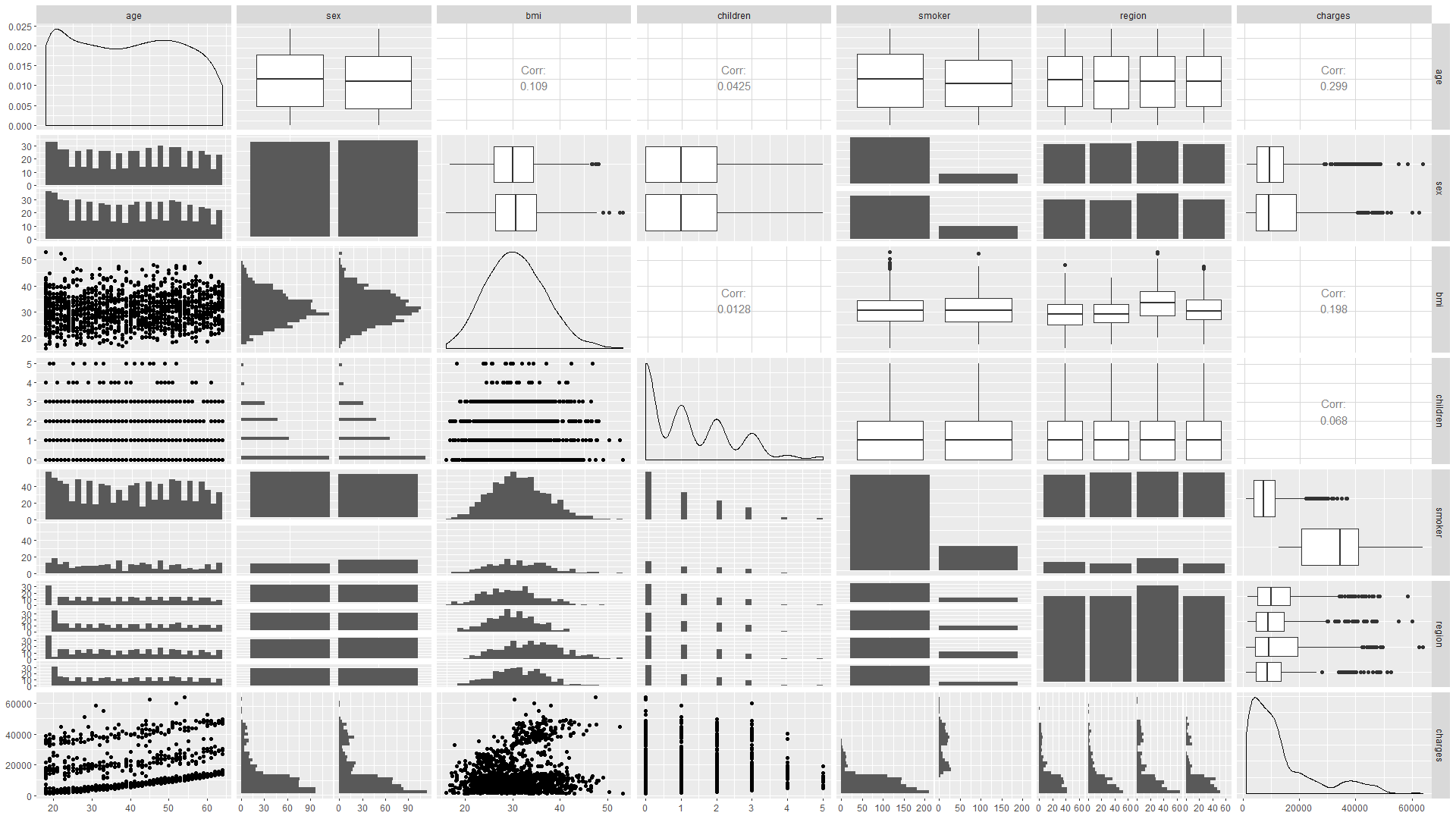Exploratory data analysis (EDA) in R
Hello friends! today we’ll be see how to do exploratory data analysis (EDA) in R. EDA is an approach to analyse data and start with it read more. I’ve used medical cost data from Kaggle.
Start with loading some packages in R and read data.
library(ggplot2) library(dplyr) library(GGally) library(tidyr)
#read data ins<- read.csv("insurance.csv")
Basic inspection
> head(ins) age sex bmi children smoker region charges 1 19 female 27.900 0 yes southwest 16884.924 2 18 male 33.770 1 no southeast 1725.552 3 28 male 33.000 3 no southeast 4449.462 4 33 male 22.705 0 no northwest 21984.471 5 32 male 28.880 0 no northwest 3866.855 6 31 female 25.740 0 no southeast 3756.622
So data has 7 columns which has information demographic info and medical charges.
Lets check the data and columns structure.
>str(ins) 'data.frame': 1338 obs. of 7 variables: $ age : int 19 18 28 33 32 31 46 37 37 60 ... $ sex : Factor w/ 2 levels "female","male": 1 2 2 2 2 1 1 1 2 1 ... $ bmi : num 27.9 33.8 33 22.7 28.9 ... $ children: int 0 1 3 0 0 0 1 3 2 0 ... $ smoker : Factor w/ 2 levels "no","yes": 2 1 1 1 1 1 1 1 1 1 ... $ region : Factor w/ 4 levels "northeast","northwest",..: 4 3 3 2 2 3 3 2 1 2 ... $ charges : num 16885 1726 4449 21984 3867 ...
Children is discrete values so changing it to factors.
ins$children<- as.factor(ins$children)
Lets check some vizzes
Plot1 <- ggplot(ins, aes(sex,charges))+geom_boxplot()
Male median medical charges are more than female.

Smokers v/s Non-smokers
Plot2 <- ggplot(ins, aes(bmi,charges, col=smoker))+geom_point()
Clearly smokers are paying more medical charges than non-smokers.

Plot3 <- ggpairs(ins)
Plotting ggpairs and checking the relationship.

Smokers v/s non-smoker Parents
Mother
> ins %>% filter(children!=0,sex=="female") %>% group_by(smoker) %>% summarise(Avgbmi= mean(bmi), AvgCharges= mean(charges), n=n()) smoker Avgbmi AvgCharges n 1 no 30.7 9577. 311 2 yes 29.0 30674. 62
Father > ins %>% filter(children!=0,sex=="male") %>% group_by(smoker) %>% summarise(Avgbmi= mean(bmi), AvgCharges= mean(charges), n=n()) smoker Avgbmi AvgCharges n 1 no 30.8 8509. 294 2 yes 32.0 33770. 97
Average medical charges for smoker fathers are more than smoker mothers.
Checking region effects
> ins %>% group_by(region) %>% + summarise(Avgbmi= mean(bmi), AvgCharges= mean(charges), n=n()) region Avgbmi AvgCharges n 1 northeast 29.2 13406. 324 2 northwest 29.2 12418. 325 3 southeast 33.4 14735. 364 4 southwest 30.6 12347. 325
Southeast region population paying more for medical charges.
for different age group also southeast region is paying the most
> ins %>% group_by(agegp,region) %>% + summarise(Avgbmi= mean(bmi), AvgCharges= mean(charges), n=n()) agegp region Avgbmi AvgCharges n 1 18-25 northeast 28.6 9179. 73 2 18-25 northwest 28.5 8245. 76 3 18-25 southeast 33.7 10431. 84 4 18-25 southwest 28.7 8325. 73 5 25-35 northeast 28.0 10891. 64 6 25-35 northwest 28.7 10436. 64 7 25-35 southeast 33.0 9755. 74 8 25-35 southwest 30.8 10999. 66 9 35-45 northeast 28.3 14448. 64 10 35-45 northwest 29.6 11070. 64 11 35-45 southeast 32.2 15933. 73 12 35-45 southwest 30.5 12159. 63 13 45-55 northeast 30.7 16241. 70 14 45-55 northwest 29.7 15513. 68 15 45-55 southeast 34.0 18402. 76 16 45-55 southwest 30.8 13571. 70 17 55+ northeast 30.4 17264. 53 18 55+ northwest 29.7 18450. 53 19 55+ southeast 33.9 21122. 57 20 55+ southwest 32.8 18173. 53
Again for different age group also southeast region’s medical charges are the highest.
Ratio of medical charges for different ages
> Agecharges <- ins %>% group_by( age,sex, smoker) %>% summarise(AvgCharges= mean(charges)) > spread(abc2, key = smoker, value = AvgCharges) age sex no yes 1 18 female 3717. 26862. 2 18 male 2696. 24779. 3 19 female 3880. 24897. 4 19 male 3220. 29106. 5 20 female 2484. 19523. 6 20 male 4863. 28616. 7 21 female 4516. 15359. 8 21 male 3211. 17942. 9 22 female 2706. 34752. 10 22 male 2396. 38684. # ... with 84 more rows Spreading across different ages and smoker gives a better picture and the smokers are paying almost 10 times the non-smokers.
This tutorial is just to create a base for the EDA. I’ll add linear regression model with some more examples.
Further readings:
Keep visiting Analytics Tuts for more tutorials.
Thanks for reading! Comment your suggestions and queries.

Before diving in, think about what you’re trying to discover. What questions are of interest? You will first walk through an analysis of the dataset. What does it look like? How many songs are there? How are the lyrics structured? How much cleaning and wrangling needs to be done? What are the facts? What are the word frequencies and why is that important? From a technical perspective, you want to understand and prepare the data for sentiment analysis, NLP, and machine learning models.